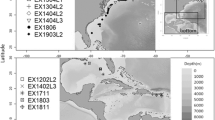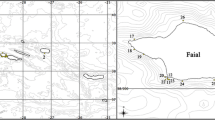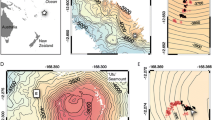Abstract
The seafloor of the Molucca and Celebes Seas, Indonesia, was investigated using a remotely operated vehicle with high-definition video during 18 dives to depths of 280 to 3200 m. Irregular slopes and rocky substrata supported abundant megabenthos, including stalked crinoids. Video zoomed on many individuals provided enough details to assign 770 stalked crinoids to major taxa and many to species level. These taxa included Guillecrinus neocaledonicus, Ptilocrinus cf. amezianeae, three species of Hyocrinus, an unknown phrynocrinid, Naumachocrinus hawaiiensis, Proisocrinus ruberrimus, Endoxocrinus alternicirrus, seven phenotypes in the Subfamily Metacrininae and one taxon of unknown affiliation. A novel observation of a juvenile Endoxocrinus included the attachment disk to a rocky surface. Taxa usually considered rare were well represented on hard substrata, thus expanding knowledge of their depth distributions. Mostly, stalked crinoids were sparsely distributed in low densities (to 186 individuals per km), except for occasional single-species clusters. Metacrinins and P. cf. amezianeae dominated at depths of 250–600 m, while E. alternicirrus and G. neocaledonicus were the most abundant species at a depth range of 1000–1400 m. The largest peak of species richness (with nine of the 17 taxa identified) occurred at 1000 to 2000 m. Many specimens altered their feeding posture with current intensity, but a balloon-like crown posture is common in low or non-existent currents. The postures of several mobile metacrinin individuals suggest an active role of arms and cirri in slow crawling movements. The possible origin of some taxa from either Gondwanaland or Eurasian margins is discussed using biogeographical and paleontological data. The location of the Wallace line cannot be delimited only using extant stalked crinoid distribution.
























Similar content being viewed by others
References
Améziane N (1997) Echinodermata Crinoidea: Les Pentacrines récoltées lors de la campagne Karubar en Indonésie. In: Crosnier A, Bouchet P (eds) Résultats des Campagnes MUSORSTOM. Volume 16. Mem Mus Natl Hist Nat (Paris) 172:627–667
Améziane N, Roux M (1997) Biodiversity and historical biogeography of stalked crinoids (Echinodermata). Biodivers Conserv 6:1557–1570
Améziane N, Roux (2001) The seamount crinoid fauna off southern Tasmania (preliminary results). In: Baker M (ed) Echinoderm 2000, Balkema, Rotterdam
Améziane N, Roux M (2005) Environmental control versus phylogenetic fingerprint in ontogeny: the example of the development of the stalk in the genus Guillecrinus (stalked crinoids, Echinodermata). J Nat Hist 39(30):2815–2859
Améziane N, Roux M (2011) Stalked crinoids from Southern Tasmanian Seamounts. part 1: Family Hyocrinidae. J Nat Hist 45:137–170
Améziane-Cominardi N (1991) Distribution bathymétrique des pentacrines du Pacifique occidental. Essai de modélisation et d’application aux faunes du Lias. Problèmes de tectono-eustatisme au cours du rifting téthysien. Doc Lab Géol Lyon 116:1–253
Améziane-Cominardi N, Bourseau JP, Avocat R, Roux M (1990) Les Crinoïdes pédonculés de Nouvelle-Calédonie: inventaire et réflexions sur les taxons archaïques. In: de Ridder C, Dubois P, Lahaye MC, Jangoux M (eds) Second Eur Conf Echinoderms, Brussels, Belgium. Balkema, Rotterdam, pp 117–124
Baumiller TK (2008) Crinoid ecological morphology. Annu Rev Earth Planet Sci 36:221–249
Baumiller TK, Gazdzicki A (1996) New crinoids from the Eocene La Meseta formation of Seymour Island, Antarctic peninsula. Palaeontol Pol 55:101–116
Baumiller TK, Messing CG (2007) Stalked crinoid locomotion and its ecological and evolutionary implications. Paleontol Electron 10:1–10
Baumiller TK, LaBarbera M, Woodley JD (1991) Ecology and functional morphology of the isocrinid Cenocrinus Asterius (Linnaeus) (Echinodermata: Crinoidea): in situ and laboratory experiments and observations. Bull Mar Sci 48:731–748
Birenheide R, Motokawa T (1994) Morphological basis and mechanics of arm movements in the stalked crinoids Metacrinus rotundus (Echinodermata, Crinoidea). Mar Biol 12:273–283
Birenheide R, Yokoyama K, Motokawa T (2000) Cirri of the stalked crinoid Metacrinus rotundus: neural elements and the effect of cholinergic agonists on mechanical properties. Proc R Soc Lond 267B:7–16
Bourseau JP, Roux M (1989) Echinodermes: Crinoïdes Pentacrinidae (Musorstom 2 et Corindon 2). Mem Mus Natl Hist Nat (Paris) 143:113–201
Bourseau JP, Cominardi N, Roux M (1988) La zonation bathymétrique des crinoïdes pédonculés actuels: un modèle de référence pour les reconstitutions paléobathymétriques. Géol Mediterr 15:83–89
Bourseau JP, Améziane-Cominardi N, Avocat R, Roux M (1991) Echinodermata :Les crinoïdes pédonculés de Nouvelle-Calédonie. Mem Mus Natl Hist Nat (Paris) 151:229–333
Bowden DA, Schiaparelli S, Clark MR, Rickard GJ (2010) A lost world? Archaic crinoid-dominated assemblages on an Antarctic seamount. Deep-Sea Res Pt II 58:119–127. doi:10.1016/j.dsr2.2010.09.006
Carpenter PH (1884) Report upon the Crinoidea collected during the voyage of the H.M.S. challenger during the years 1873–1876. part I:general morphology with descriptions of the stalked crinoids. Rep Scient Res Voy HMS Challenger (Zool) 11(32):1–442
Clark AH (1908) Preliminary notice of a collection of recent crinoids from the Philippines islands. Smith Misc Collect, Quart Issue 52:199–234
Clark AH (1910) Proisocrinus, a new genus of recent crinoids. Proc U S Nat Mus 38:387–390
Clark AH (1911) Thalassocrinus, a new genus of stalked crinoid from East Indies. Proc U S Nat Mus 39(1793):473–476
Clark AH (1912) Naumachocrinus, a new genus belonging to the crinoid family Phrynocrinidae. Proc U S Nat Mus 42(1985):195–197
Clark AH (1915) A monograph of the existing crinoids. 1. the comatulids. Bull US Nat Mus 82:1–406
Clark AM (1973) Some new taxa of recent stalked Crinoidea. Bull Br Mus Nat Hist 25:267–288
Conan G, Roux M, Sibuet M (1981) A photographic survey of a population of the stalked crinoid Diplocrinus (Annacrinus) wyvillethomsoni (Echinodermata) from the bathyal slope of the Bay of Biscay. Deep-Sea Res 5:441–453
David J, Roux M, Messing CG, Améziane N (2006) Revision of the pentacrinid stalked crinoids of the genus Endoxocrinus (Echinodermata, Crinoidea), with a study of environmental control of characters and its consequences for taxonomy. Zootaxa 1156:1–5
Döderlein L (1907) Die gestielten crinoiden der Siboga-expedition:Siboga Expedite:Uit komsten op zoologish, botanisch, oceanographisch Oost-Indie (1899–1900). EJ Brill, Leiden
Donovan SK (2001) Evolution of Caribbean echinoderms during the Cenozoic: moving towards a complete picture using all of the fossils. Paleogeogr Palaeoclim Paleoecol 166:177–192
Donovan SK, Pawson DL (1994) Skeletal morphology and paleontological significance of the stem of extant Phrynocrinus nudus A.H. Clark (Echinodermata:Crinoidea). J Paleont 68:1336–134
Eagle MK (2004) Saracrinus (Crinoidea, Metacrininae) from the Early Miocene of Motuketekete Island, Hauraki Gulf, Auckland, New Zealand. Rec Auckl Inst Mus 41:5–12
Eléaume M, Améziane N, Chao SM (2007) First records of the stalked crinoid fauna (Echinodermata: Crinoidea) of Taiwan. Syst Biodivers 5:435–453
Eléaume M, Hemery LG, Bowden DA, Roux M (2011) A large new species of the genus Ptilocrinus (Echinodermata, Crinoidea, Hyocrinidae) from Antarctic seamounts. Polar Biol 34:1385–1397
Eléaume M, Bohn JM, Roux M, Améziane N (2012) Stalked crinoids (Echinodermata) collected by the R/V Polarstern and Meteor in the south Atlantic and Antarctica. Zootaxa 3425:1–22
Eléaume M, Hemery LG, Roux M, Améziane N (2014) Southern Ocean crinoids. In: De Broyer C et al. (eds) Biogeographic atlas of the Southern Ocean. Scientific Committee of Antarctic Research, Cambridge, 5–25:208–212
Fujita T, Ohta S, Oji T (1987) Photographic observation of the stalked crinoid Metacrinus rotundus Carpenter in Suruga Bay, central Japan. J Oceanogr Soc Jap 43:333–343
Gislén T (1925) Two stalked crinoids from the Kei Islands. Vidensk Medd fra Dansk Naturh Foren 79:85–95
Gislén T (1938) A revision of the recent Bathycrinidae with a study of their phylogeny and geographical distribution. Lunds Universitets Arsskrift NF 2(34):1–30
Hall R, Smyth HR (2008) Cenozoic arc processes in Indonesia: identification of the key influences on the stratigraphic record in active volcanic arcs. Geol S Am S 436:27–54
Hemery LG (2011) Diversité moléculaire, phylogénie et phylogéographie des Crinoïdes (Echinodermes) dans un environnement extrême: l’océan Austral. Dissertation, Muséum national d’Histoire naturelle, Paris
Hemery LG, Roux M, Améziane N, Eléaume M (2013) High-resolution crinoid phyletic inter-relationships derived from molecular data. Cah Biol Mar 54:511–523
Kitazawa K, Oji T (2014) Active feeding behavior of and current modification by the sea lily Metacrinus rotundus (Echinodermata:Crinoidea). J Exp Mar Biol Ecol 453:13–21
Klikushin VG (1982) Taxonomic survey of fossil isocrinids with a list of the species found in the USSR. Geobios 15:299–325
Lambert B, Roux M (1991) The bathyal carbonate environment off New Calédonia (ENVIMARGES Program). Doc et Trav, IGAL, Paris 15:1–213
Macurda DB Jr, Meyer DL (1974) Feeding posture of modern stalked crinoids. Nature 247:394–396
Macurda DB Jr, Meyer DL (1976) The identification and interpretation of stalked crinoids (Echinodermata) from deep-water photographs. Bull Mar Sci 26:205–215
McConachy TF, Permana H, Binns RA, Zulkarnain I, Parr JM, Yeats CJ, Hananto N, Priadi B, Burhanuddin S, Utomo EP (2004) Recent investigations of submarine hydrothermal activity in Indonesia. Proc Pacific Rim ‘95 Congress, Adelaide, SA AusIMM Publ 9/94:161–172
McKnight DG (1979) Phrynocrinus nudus A.H. Clark—a stalked crinoid new to New Zealand waters. NZ J Mar Freshw Res 13:497–499
McKnight DG (1989) Further crinoids (Echinodermata) from off the Kermadec Islands, southwest Pacific Ocean. NZ Oceanogr Inst Div Mar Freshw Sci Rep 3:31–35
Messing CG (1985) Submersible observations of deep-water crinoid assemblages in the tropical western Atlantic Ocean. In: Keegan BF, O’Connor BDS (eds) Echinodermata. Balkema, Rotterdam, pp 185–193
Messing CG (2004) Biozonation on deep-water carbonate mounds and associated hard grounds along the western margin of little Bahamas Bank with notes on the Caicos Platform island slope. In: Lewis RD, Panuska BC (eds) Proc 11th Symp on the geology of the Bahamas and other carbonate regions. Gerace Research Center, Bahamas, pp 107–115
Messing CG (2007) The crinoid fauna (Echinodermata:Crinoidea) of Palau. Pac Sci 61:91–111
Messing CG, RoseSmyth MC, Mailer SR, Miller JE (1988) Relocation movement in a stalked crinoid (Echinodermata). Bull Mar Sci 43(3):480–487
Messing CG, Neumann AC, Lang JC (1990) Biozonation of deep-water lithoherms and associated hard grounds in the northeastern Straits of Florida. Palaios 5:15–33
Mironov AN (2000) New taxa of the stalked crinoids of the suborder Bourgueticrinina. Zool zh 79:712–728 (In Russian)
Mironov AN, Sorokina OA (1998) Sea lilies of the order Hyocrinida (Echinodermata, Crinoidea). Zoologicheskie Issledovania 2:1–117
Oji T (1990) Miocene Isocrinidae (stalked crinoids) from Japan and their biogeographic implication. Trans Proc Palaeontol Soc Jpn 157:412–429
Oji T, Kitazawa Y (2006) Distribution of stalked crinoids (Echinodermata) from waters off the southern coasts of Japan. Mem Natl Sci Mus 41:217–222
Oji T, Kitazawa K (2008) Discovery of two rare species of stalked crinoids from Okinawa Trough, southwestern Japan and their systematic and biogeographic implications. Jpn Zool Sci 25:115–120
Oji T, Ogawa Y, Hunter AW, Kitazawa K (2009) Discovery of dense aggregations of stalked crinoids in Izu-Ogasawara Trench. Japan Zool Sci 26:406–408
Pieters FF, de Visser J (1993) The scientific career of the zoologist Max Wilhelm Carl Weber (1852–1937). Bijd Dierkd 62:193–214
Rouse GW, Jermiin LS, Wilson NG, Eeckhaut I, Lanterbecq D, Oji T, Young CM, Browning T, Cisternas P, Helgen LE, Stuckey M, Messing CG (2013) Fixed, free and fixed: The fickle phylogeny of extant Crinoidea (Echinodermata) and their Permian-Triassic origin. Mol Phyl Evol 66:161–181
Roux M (1980) Découverte de sites à crinoïdes pédonculés (genres Diplocrinus et Proisocrinus) au large de Tahiti. CR Acad Sci Paris, Série D 290:119–122
Roux M (1981) Echinodermes: Crinoïdes Isocrinidae. In: Résultats des campagnes MUSORSTOM 1, Philippines (18–28 mars1976). Mémoires ORSTOM 91:477–543
Roux M (1985) Les crinoïdes pédonculés de l’Atlantique N.E.: Inventaire, écologie et biogéographie. In: Laubier L, Monniot C (eds). Peuplements profonds du Golfe de Gascogne. Ifremer, Paris 41:479–489
Roux M (1987) Evolutionary ecology and biogeography of recent stalked crinoids as a model for the fossil record. In: Jangoux M, Lawrence JM (eds) Echinoderm studies 2. Balkema, Rotterdam, pp 1–53
Roux M (1994) The CALSUB cruise on the bathyal slopes off New Caledonia. Mem Mus Natl Hist Nat Paris 161:9–47
Roux M (2004) New hyocrinid crinoids (Echinodermata) from submersible investigations in the Pacific Ocean. Pac Sci 58:597–613
Roux M, Montenat C (1977) Sites à Crinoïdes pédonculés et bathymétrie des bassins messiniens dans les Cordillières bétiques orientales (Espagne méridionale). Bull Soc Geol Fr 19:405–416
Roux M, Bourseau JP, Bas T, de Gracianski PC, Lemoine M, Rudkiewicz JL (1988) Bathymetric evolution of the Tethyan margin in the western Alps (data from stalked crinoids): a reappraisal of eustatic problems during the Jurassic. Bull Soc Geol Fr 8:633–641
Roux M, Messing CG, Ameziane N (2002) Artificial keys to the genera of living stalked crinoids (Echinodermata). Bull Mar Sci 70:799–830
Roux M, Cahuzac B, Sztrakos K (2006) Les paléoenvironnements éocènes à Crinoïdes pédonculés des marnes de Miretrain (Angoumé, SW de la France): interprétations paléobathymétriques. C R Geosci Paris 338:262–271
Roux M, Améziane N, Eléaume M (2009) The genus Teliocrinus (Crinoidea, Echinodermata): a key taxon among pentacrinid stalked crinoids. Zool J Linnean Soc 155:22–39
Roux M, Eléaume M, Hemery LG, Améziane N (2013) When morphology meets molecular data in crinoid phylogeny: a challenge. Cah Biol Mar 54:541–548
Shortis MR, Seager JW, Williams A, Baker BA, Sherlock M (2007) A towed body stereo-video system for deep water benthic habitat surveys. In: Grun A, Kahmen H (eds) 8th Conf Opt 3-D Meas Techn ETH Zurich, Zurich, pp 150–157
Sieverts H (1933) Jungtertiäre Crinoiden von Seran und Borneo. N Jb Min B 69:145–168
Staudigel H et al (2006) Vailulu’u Seamount, Samoa: life and death on an active submarine volcano. PNAS 103(17):6448–6453. doi:10.1073/pnas.0600830103
Tyler PA, Zibrowius H (1992) Submersible observations of the invertebrate fauna on the continental slope southwest of Ireland (NE Atlantic Ocean). Oceanol Acta 15:211–226
Widiwijayanti C, Tiberi C, Deplus C, Diament M, Mikhailov V, Louat R (2004) Geodynamic evolution of the northern Molucca Sea area (Eastern Indonesia) constrained by 3-D gravity field inversion. Tectonophysics 386:203–222
Acknowledgments
We are grateful to: Steven Hammond, David McKinnie, Jeremy Potter and Sugiarta Wirasantosa for facilitating the evolution of the INDEX plans; Jim Holden and Tim Shank for shoreside science oversight, and Santiago Herrerra, John Sherrin, Rainer Troa, and Xerandy as interfaces for telepresence research on board; Cherisse Du Preez and Rachel Brown for help with dive logging; Meme Lobecker and Kelley Elliott (NOAA) for the multibeam map; and Jessica Nephin for some crinoid observations and density estimates. Special thanks to Jonathan Rose, who mastered video capture, logged dives, captured images and helped with manuscript production. We thank Nadia Améziane (MNHN), Franzis Althaus, Karen Gowlett-Holmes, Felicity McEnnulty, and Alan Williams (CSIRO), who provided information and access to deep-sea photographs of stalked crinoids off SE Australia and Tasmania. Thanks are also due to Gert Woerheide (LMU) for pictures and a specimen of Porphyrocrinus collected during the Deep Downunder Expedition (funded by the German Science Foundation Projects Wo896/7 & LU839/2). The INDEX expedition was funded by National Oceanic and Atmospheric Administration’s Ocean Exploration Program, and supported by several agencies of the US and Indonesian governments. VT was funded by the Canada Research Chairs Foundation. MR and ME were funded by various MNHN grants: “Actions Transversales”: “Biodiversité actuelle et fossile. Crises, stress, restaurations et panchronisme : le message systématique”, “Emergences”, “Formes possibles, Formes réalisées” and “Interactions Minéral-Vivant”
Author information
Authors and Affiliations
Corresponding author
Additional information
Communicated by J. Gutt
Electronic supplementary material
Below is the link to the electronic supplementary material.
Online Resource 1 (file ESM_1.mpg)
Video of the phrynocrinid encountered on dive III-5 at 1565 m depth. (MPG 46166 kb)
Online Resource 2 (file ESM_2.mpg)
Video of setting and features of Proisocrinus ruberrimus on dive III-3 at 1778 m depth. (MPG 114052 kb)
Online Resource 3 (file ESM_3.mpg)
Video of encounter with ledge of metacrinins (phenotype 4, perhaps Metacrinus nodosus) and detail on one specimen on dive III-14 at 1175 m depth. (MPG 46046 kb)
Online Resource 4 (file ESM_4.xlsx)
Table of identifiable stalked crinoids by taxon on each dive of the INDEX Expedition to the Celebes Sea, Molucca Sea and Sangihe Arc, Indonesia. (XLSX 12 kb)
Rights and permissions
About this article
Cite this article
Tunnicliffe, V., Roux, M., Eléaume, M. et al. The stalked crinoid fauna (Echinodermata) of the Molucca and Celebes Seas, Indonesia: taxonomic diversity and observations from remotely operated vehicle imagery. Mar Biodiv 46, 365–388 (2016). https://doi.org/10.1007/s12526-015-0369-x
Received:
Revised:
Accepted:
Published:
Issue Date:
DOI: https://doi.org/10.1007/s12526-015-0369-x




